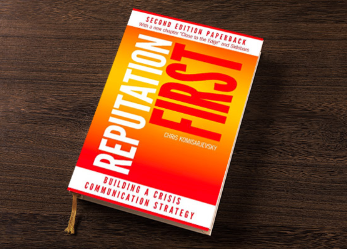Book Review – “Reputation First Second Edition: Building a Crisis Communication Strategy”
by Robert A. Scott
The leadership crises following the Congressional Hearing of the presidents of three elite universities underscored the need for a crisis communications plan. Legal preparation is not sufficient. The presidents seem to have been prepared for courthouse decorum but found themselves bullied in a manner they had not anticipated. Their preparation should have included a review of the items on the institutional risk management matrix. These include reputation along with legal, compliance, information security, and disaster recovery, among others.
In "Reputation First Second Edition: Building a Crisis Communication Strategy," Chris Komisarjevsky, retired CEO of Burson-Marsteller, a major public relations firm, sets out the elements of a strategy. He says reputation is the one element of leadership that earns support and makes it possible to survive and, better yet, thrive in the aftermath of a crisis. Furthermore, he asserts that reputation has four components: character, behavior, communication, and trust. Little is more important than "a comparison of what we say and what we do," according to him.
In the aftermath of the Congressional Hearing on antisemitism on college campuses, one president resigned and a second was saved for the time being by her board's affirmation of her appointment. "Reputation First Second Edition: Building a Crisis Communication Strategy" would be a good primer for leaders of universities and other organizations, including both corporate and religious.
In Part One, the book describes and develops the elements of "reputation," including behavior, i.e., the tone at the top; trust, meaning authenticity and transparency; the strength of personal character; and personal engagement in the era of "social skills." Each chapter includes examples from current and well-known past events such as the Boeing 727 Max crashes, Panama and the Pandora Papers that disclosed widespread corruption, and the British Petroleum and Deepwater Horizon crisis that resulted in guilty verdicts for manslaughter and putting profits over prudence, and a $4bn fine. The details help the reader understand the principles enunciated and the consequences found in action and in-action.
For example, he provides some "very clear action steps" that will affect how others judge the character of the leader and the organization:
- Check your ego at the door
- Be personal
- Be everywhere (Manage by walking around): Reach out in unusual and unexpected ways
- Take the pain to explain
- Don't be afraid to stand out
- Create a framework of caring
- Remember first impressions
- Be transparent
- Admit where you went wrong, among various other gems.
In Part Two, the focus is on "crisis," which Komisarjevsky describes as a fact of life that must be met head-on with a plan that is well-executed. Each chapter includes examples that describe the kinds of crises that occur, the actions required, the nature of a plan, the need for action as well as empathy for people, briefing the board, lessons learned and employed, and the basics of recovery.
The examples described are valuable in themselves. The author goes behind the headlines in describing the crises experienced by Novartis settling charges for kickbacks and payoffs, HSBC for money laundering, Goldman Sachs for an inhumane workplace, Apollo II and contingency planning, and Ernst & Young for cheating scandal and fine. From these experiences, he draws inferences from which he enumerates principles. Crises follow a pattern, and there are stages in each:
- Stage One: Look Forward -- Plan and Prepare
- Stage Two: Listen Carefully -- Early Warning
- Stage Three: Investigate -- Fact Finding
- Stage Four: Activate -- The Tactical Operations Center Goes Live
- Stage Five: Act Aggressively -- Time to Speak
- Stage Six: Monitor and Review -- How's it going?
- Stage Seven: Start Recovery -- New Phase Opens
- Stage Eight: Learn for the Future -- Evaluate
- Stage Nine: Start the Cycle Again - No Time to Relax
In addition, the book includes a foreword by Gene McCarthy, chairman of the Board of FootBalance System, Ltd.; lessons from Red Adair, the legendary oil well firefighter; and an afterword by Pat Ford, retired vice chairman of Burson-Marsteller. Their comments add additional wisdom from experience to the philosophy and examples included in the text.
In summary, leaders are responsible for the assets of an institution or organization, and reputation is a particularly valuable asset. We must guard it with all we can because it will make a difference in the recovery from a crisis. It will provide us with the benefit of the doubt during a troubling period, something the presidents testifying before Congress lacked. Chris Komisarjevsky provides a roadmap for preserving and enhancing reputations that can provide a benefit of the doubt at a critical time.
This article is republished from HigherEdJobs® under a Creative Commons license.
